
|   |

|   |
Konark Dance Festival 2012 - Dr. Sunil Kothari e-mail: sunilkothari1933@gmail.com Photos: Arbinda Mahapatra for Odisha Tourism December 11, 2012 The festive mood When we arrived at Konark from Bhubaneswar, what we saw was indeed a festive mood. Right from the various colourful decorations on several trees leading to the venue and to the entrance of Yatri Niwas where an exhibition of paintings was mounted on the lawns, the huge posters announcing Konark Dance Festival 2012, the music played by the mahuri and nagada players to the presentation of folders about Konark Dance Festival and Tourism, we could see that the man behind the festival had taken pains giving attention to minutest details, leaving no stone unturned, to make the visitors feel that they had come 'to the land of festivals.' Under his passionate zeal and a commendable ability to get all involved in mounting the festival, the principal secretary, Dept of Culture and Tourism. Mr. A.K. Tripathy has left his signature on the festival. The group of artistes including Aruna Mohanty (Odissi exponent and Vice President of Odisha Sangeet Natak Akademi), Ratikant Mohapatra (guru, performer and son of legendary Guru Kelucharan Mohapatra), his associate Deviprasad Mishra aka Tikki, Sangeeta Mahapatra (Reader in vocal music at the newly established Utkal University of Culture), Ram Hari Das (musician and Director of GKMORC, Professor in Music at Utkal University of Culture), were in charge of the smooth running of the festival. From exquisite lighting, seating arrangements, sound system, clean and artistic vast stage, with magnificent view of the tower of Konark temple, Dr. Mrityunjay Rath, the ace compere in Odiya language and celebrated compere Sadhna Shrivastav with her vast experience for nearly three decades, the highly professional approach no wonder places Konark Dance Festival in the international category! In the evening, as it were the stars descended upon the earth and lit up the trees, hundreds of colourful lamps, with cylindrical thumbus like hangings from Pipli village, the umbrellas, the long garlands of small bulbs, the flags, and the path leading to the stage and open air auditorium with floor designs, hangings beautifying the path added to the festive atmosphere. It looked like Diwali, festival of lamps. The disciplined way the audience was led to take the seats, the upper gallery with tasteful canopy for lighting completed the ambience putting the audience in a pleasant mood. I had missed the festival for nearly eight to nine years and when I saw the metamorphosis, I was absolutely overwhelmed. Many who came to the venue after an interval of few years complimented Mr. A.K. Tripathy, who was seen attending to various details of the festival. Now in its 24th year I was involved with the festival from the beginning when Kum Kum Mohanty conceived it and with help of the Chief Minister Biju Patnaik, formed a committee including dance experts, gurus, and bureaucrats and organized it in 1989 at the open air auditorium which was specially constructed with the financial assistance of the Government of India. The dual objective was to promote classical dances of India and Konark as well as Odisha as a tourist destination. A makeshift Yatri Niwas was also built where dancers could be accommodated. In order not to have any objection from the Archaeological Department, the site was chosen away from the main temple, keeping in view the existing tall shikhara of the Konark temple, which formed the backdrop. It was quite exciting for all of us to get involved in various details, and I remember our annual meetings for selection of dancers. Initially, during 1989 and 1990, the festival was organized for a period of three days only. Subsequently it was increased to seven days during 1991 and 1992 on different dates. Since 1993, the festival is being organized for a period of five days from 1st to 5th December every year. The only year it was not organized was during 1999 due to the super cyclone. I attended it every year till 2000 but could not after that on account of my other engagements. However, this year when I received the formal invitation, I was delighted to attend and saw for myself what a marvelous transformation it has undergone. The participating dancers were, on arrival, put up at Bhubaneswar, but soon joined for the rehearsals at Konark and stayed overnight after the performance at Yatri Niwas. It was like a get together for all of us over dinner and breakfast, discussing finer points of the performances. We used to have similar interactions at Khajuraho Dance Festival and were reminded of those halcyon days. A galaxy of dancers This year, Konark Dance Festival (1-5 Dec 2012) featured a galaxy of well established dancers -Mallika Sarabhai and her Darpana dance troupe from Ahmedabad (Bharatanatyam), Raja and Radha Reddy and their Natya Tarangini dance troupe from Delhi (Kuchipudi), Bharati Shivaji and her troupe from Centre for Mohiniattam also from New Delhi (Mohiniattam), Malabika Mitra and her troupe of Shibpur Onkar Dances and Music Centre from Kolkata (Kathak), Anita Sharma and her troupe of Abhinay Dance Academy, Guwahati (Sattriya), Madhavi Mudgal and Gandharva Mahavidyalaya's disciples from New Delhi, Meera Das with her troupe of Gunjan Dance Academy, Cuttack, Kasturi Pattanaik with disciples of her institute Sankalpa from New Delhi and dancers of Guru Kelucharan Mohapatra Odissi Research Centre and Utkal University of Culture (Odissi), recently established in 1991. The festival was flagged off with Madhavi Mudgal and her troupe's Odissi group presentation. Day one 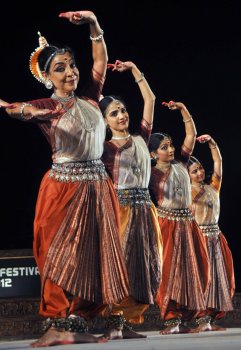 Madhavi Mudgal's group
On the opening day, in memory of late Prime Minister of India, Mr. I.K.
Gujral, silence for one minute was observed as a mark of respect. At
Konark on account of the large stage, as a policy decision the dancers
participate with their group so that the visual impact is aesthetically
pleasant and a solo dancer is not lost on the stage. It also helps
dancers to choreograph pure dance numbers with nritta
explorations. Any abhinaya number is lost to the masses as unless they
are closer to the stage, the subtle expressions are not registered by
the audiences. Madhavi opened with Gangastavana, to the music composed
by her brother Pandit Madhup Mudgal, using her eight dancers in various
flowing water formations, she as a narrator describing the majestic
power of Ganga, from veracious peaks of the Himalayas descending upon
matted locks of Lord Shiva. This was imaginatively choreographed. The
dancers, all of equal height and dressed in burnt brown and yellow
costumes, visually looked very pleasing. Madhavi's choreography explores
the tala element and while deconstructing individual movements, she
builds upon various elements with geometrical patterns, which appear
seamless and never look clumsy. Be it Gita Govinda ashtapadis in a dramatized form with Arushi Mudgal playing Krishna's role and other dancers turning into clusters of trees of kunj, bower of Brindavan, or flowing river and the bank of Jamuna, the group alignment was clean and left visual impact. With vast experience and the infrastructure at Gandharva Mahavidyalaya , the music composed by Madhup Mudgal, and lighting by long time associate Gautam Bhattacharya, the choreographic works of Madhavi succeed in lingering long in one's eye, recalling formations. In Kishore chandranana champu kavya of Kavisurya Baldev Rath, with 'K' and 'Kha' champu, the singing did not help in understanding the sahitya which was being transformed into kinetic language of dance. Radha's character was impersonated by different dancers besides Arushi, giving it a brilliant touch of suggestion, that all devotees are Radha, and Radha's infatuation for Krishna and attendant dangers which Radha does not fully realize, were danced in a beautiful manner. Radha's drawing images on sand thinking of Krishna, rubbing them off as soon as the sakhis make fun of her, her bashfulness, the images of snake charmer, madari, playing mahuri (musical instrument) and capturing the serpents, sakhis indicating Radha getting mesmerized by Krishna, not knowing that he has subjugated Kaliya, and fool as she is, attempts to sleep on a bed of swords (khanda), what else can happen to her except harming herself with sharp blades, she had better think twice about falling in love with Krishna! For Odiya community, these are songs they grow up with. For connoisseurs, knowing sahitya is a delight. Madhavi could resolve issue of the singing and make abhinaya numbers more appreciative with clear enunciation. Moksha, as usual had eye catching formations, but the final shloka in praise of Surya with cut light on back of the dancers praying to Lord Jagannath was exquisite and gave an extra dimension to the finale.
Raja and Radha Reddy and their troupe followed Madhavi's presentation. Raja offered a prayer in praise of Vaishnavi Devi in raga Bhairavi which the Hindustani vocalist Aditi Sharma rendered melodiously. Raja with minimal movements, looking upwards at all pervading Shakti in various forms, as Narayani, counter part of Purusha, and in the end the dancers standing behind each other as multi- armed Goddess Durga with various weapons in her arms, to which as a devotee Raja bowed, was an excellent image. Pt Ravi Shankar has composed a lilting tarana in Nat Bhairavi raga, which is a very popular number. Raja has choreographed a pure dance number on that music. Using the upper level of the stage, the young dancers danced with eye catching Kuchipudi movements. At one juncture there was silence in the composition and audience started clapping, but soon the final movements followed and dancers earned applause again. Oothukadu Venkatasubbaiyer's "Natavar taruni Krishna" began with Krishna's rasa krida and to the epithet for Krishna for Gitopadesh, Raja wove the incident of Arjuna seeing his own relation at Kurukshetra battle field, and did not want to use Gandiva weapon to kill his own kith and kin. Krishna displays his Vishwarupa (cosmic form), instructs him to fight saying: "Karmanyeva adhikaraste, ma faleshu kadachana" (You do your job, do not expect reward), the shlokas known to every Hindu who knows Gita, the archetypal response to mythology, as a shared experience, and the audience responded with applause. "Yada yada hi dharmasya glanirbhavati Bharata," shloka evokes wonderful responses. Gitopadesha interlude received wide appreciation. Performing on rim of brass plate is de rigour for Kuchipudi dancers. Beginning with "Nitystha padarvinda, Vishwavandita Mukunda" the entire group performed on brass plates, with perfect synchronization and the audience response was heartwarming. It was obvious that there was a predominant touch of Hindustani music, barring Krishnaleela Tarangini tarangam number. It had the usual rhythmic repartee and melodious singing full of Kuchipudi flavor. But there was a general feeling on part of connoisseurs that more of Kuchipudi music was expected. DD Television telecast the entire program live. In an open air theatre, sound and microphones do create problems. Since this was a live telecast, the musicians instead of requesting organizers, when mikes were on for balancing, could have taken someone into confidence for putting mikes in order and thus avoid announcement during a live telecast. Day two Not for nothing is Mohiniattam exponent Bharati Shivaji bestowed with the title Lasya Lakshmi. Her troupe of dancers clad in alluring white sarees with gold border, gold ornaments, side buns with jasmine flowers, looked like apsaras, celestial nymphs from Kerala, dancing in graceful mode, imbibing the gentle swaying of palm trees and bobbing boats in the backwaters of Kerala. Opening with Ganapati stuti, Bharati choreographed the shloka imaginatively, describing the sopana, various steps leading to the sanctum sanctorum. In the midst of the milky ocean, there is a tree, beneath the tree there is a golden platform over which is yet another golden platform. On that is spread a silken cloth on which is sprinkled the sacred rice. On the sacred rice is Ganapati's vehicle mouse on which is seated Ganapati. The devotees pray to him to awaken him from his sleep and bless the universe. The temple doors are flung open with Ganapati swaying his trunk and ears, and his mother Goddess Parvati and father Lord Shiva are seen admiring his beauty. The entire choreography to the full throated singing of Rajagopala, eddakka and melodious strains of veena in Arabhi raga and adi tala, permeated the atmosphere with a feeling of devotion. It was followed by a prayer to Goddess Saraswati. Mohiniattam form with its inherent slow graceful movements was explored beautifully by Bharati and danced by her young sprightly dancers with elegance. Mukhachalam, a pure dance number in Ragamalika and Talamalika was performed with leisurely pace indicating the technical structure in the text with 'svaradi panchavarna taladi.' In sopana music in Kerala temples, ashtapadis of Gita Govinda are traditionally sung to this day. Bharati chose Chandana charchita neela kalebara pita vasana Vanamali ashtapadi, set to Pantuvarali raga and adi tala, her dancers playing various roles of gopis, one as Krishna, dallying with gopis. The description of Krishna and the erotic references to pinapayodhara, the heavy breasts of gopis, using a simile of birds making love, Bharati suggestively interpreted the stanza artistically. An interesting scene was of Krishna and a gopi on a swing and other gopis pushing the swing. The playfulness of Krishna and gopis was depicted with imagination. Poet Vallathol's poem Pandattam, metaphorically referring to ups and downs in a life, like ball during the play has ups and downs, was danced by all joyfully. The game of ball, Kanduka, engaged all dancers and they created an illusion of a ball being thrown across the audience and looking for it anxiously. Rendered in Kamboji raga and adi tala, the number has popular appeal and is a favourite with many dancers. As a group composition Bharati did a good job of it. The dancers made an exit in a graceful manner disappearing from the stage. 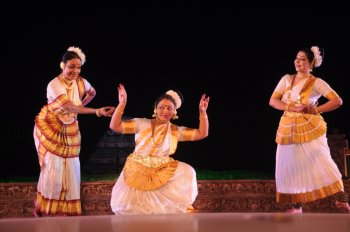 Bharati Sivaji's group 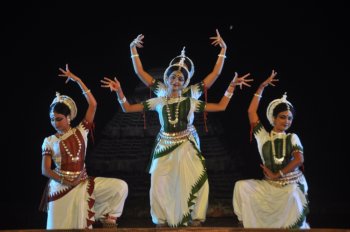 Meera Das's group Meera Das, a disciple of Guru Kelucharan Mohapatra, with her dancers from Gunjan Dance Academy from Cuttack opened the performance with Sahasranshu, one of the most celebrated epithets of Sun god. Hiranyagarbha means 'golden womb' or 'golden egg' in which was kept the seed of creation. Sun uncovers it and reveals the universal truth. Using Rigveda sukta, Meera Das with conceptual help from poet and critic Kedar Mishra, juxtaposed it with Odiya Bhagavata of Jagannath Das, who describes nature as creator's body, the sun and the moon his eyes, rivers as his veins, mountains as his bones, clouds as his hair, evening as his clothes, and humanity as his mind. The use of hastas to show flames for golden disc was powerful. With a group of well trained dancers, and using appropriate lighting by Arusam Madhusudan, the mime artist from Hyderabad, Meera created the formation of the cosmos. Meera employed yogasanas reminding one of Surya namaskar. Odissi as a dance form also offers scope for the image of chariot with seven horses. Meera has an eye for choreographic skills. Redesigning the structure of Thayi with refrain of 'ta ham ta inda kidtak,' the mnemonic bols of mardala and movements of pure dance had the old time flavor. Using music composed by Sumanta Mohanty and Rajendra Swain to tala composition by Satchidananda Das, Meera choreographed dancers playing veena, mardala, flute and manjira. In nritta, the female dancers took acrobatic poses generally found in bandhas performed by Gotipua dancers with complete ease and one dancer sat on the floor in a trice with a split. Pallavi in Desh raga sung by Nazia Alam had melodious notes and drum syllables added another dimension. A variety of sculptural poses ranging from Darpani, Alasa, Abhimana, Lajja, were executed by the slim and attractive young dancers in a perfect synchronized manner. Performing Shanti Mantra in the end, the group displayed enjoyable teamwork. The musical support was by Nazia Alam and Rupak Kumar Panda (vocal), Guru Dhaneswar Swain, Buddhinath Swain and Saubhagya Chhotray (mardala), Srinivas Satpathy (flute), Agnimitra Behera (violin). The team of musicians worked with commendable understanding highlighting the presentation. Day three Kasturi Pattanaik belonged to the first batch of trainees at Odissi Research Centre along with Meera Das, Sujata Mohapatra, Manoranjan Pradhan and others. She has received sound training under Guru Kelucharan Mohapatra. She and her Sankalpa troupe presented Odissi numbers beginning with reconstructed Thayi Ghara Nata to the mardala by Sachidananda Rath and vocals by Vinod Bihari Panda and Yashasvini Naik. The musical component was pleasant. Using Bhubaneswar Mishra's musical composition, restructuring to display development of Odissi she attempted re-arrangement to Chakrakeli raga and khemta and triputa talas. The refrain thai thai kadatak ta ham aa thai thai using chauka, tribhanga, chakra bhramari et al, was quite a laudable attempt. In her what was claimed as original Gatisamikrita Patadipa Pallavi, she employed chaturashra, tisra, khanda, sankirna and mishra jatis and also gatis of various birds and animals like mrigi gati, hasti gati, sarpa gati, mayur gati. It gave one some idea of her attempts at choreography. The music was provided by Guru Nityananda Mahapatra, which was further adapted and re-arranged by Kasturi. However, in dance drama Sthitapragna, with concept by Khirod Prasad Mohanty and script by Dr. Manmohan Acharya, the theme revolved round six enemies, shada ripu, lobh, moha, maya, matsara, kama krodha and herself playing the role of sthitapragna tapasvi, the impact was not pleasant. The story looked hackneyed and performances by various dancers representing six enemies did not show high standard. It was a disappointing number and did not coalesce with her reputation. The dancers also looked as having unequal practice and overall impression was poor. 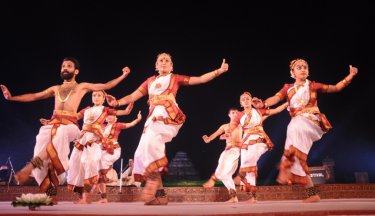 Kasturi Pattanaik's group 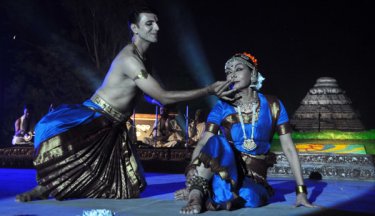 Mallika Sarabhai's group Mallika Sarabhai chose Bhajan Paddhati for group presentation. With considerable experience and powerful singer in Jayan Nair and team of musicians, Mallika succeeded in leaving a strong impression of Bharatanatyam, which is not generally performed to bhajan paddhati music. What contributed to the success of the show was lead singer and accompanists were equal partner to dance. In the beginning, I did wonder if the rendering of bhajans would overshadow the dance. But I need not have worried on that score. After initial Todaya Mangalam with lyrics Jay Janaki Ramana, Mallika moved on to other bhajans in different languages, Tamil, Marathi, Hindi, Sanskrit, traditional songs, with visuals of carrying a palanquin, a procession, bringing rituals of arati, coming down from the stage, offering it to members of audience seated in front and keeping the tempo even. The atmosphere was replete with singing of bhajans and one was transported to a village temple and community singing 'Govinda! Govinda!' Shri Venkatagirinayaka, Alamelumanga, Mohan, Madhava, Jaya Mangalam soundscape kept the mood of intense experience, when dancers changed costumes and appeared for enactment for the songs rendered. Since prayer was the main motif, there was no scope for any sancharis, dwelling upon words. Barring Gita Govinda ashtapadi, sancharadadhara, sudhamadhuradhwani, mohanmukharita vamsham, where Mallika introduced Krishna Radha episode, sakhis looking at them, Krishna and Radha in their blue costumes, nilamegha and Krishna (only described in song as pitavasana), their being together, and the use of blue light designed by Yadavan Chandran, most of the presentation dwelt upon group dance. Pandya Rajkumari, princess with shuka (parrot) on her shoulder was a brilliant image and Mallika performed a solo to the bhajan in her praise. The Murugan bhajan, the group dance of kavadi, all added to the mood with appropriate visuals. Bhajan about Lord Shiva, 'when will you come again' had deeply felt feelings. Tukaram's abhanga, 'Goda tujhe rupa, goda tujhe nama' struck familiar notes in Marathi, even prayer to Sai Baba in Hindi and reverting back to bhajan of Lord Shiva, though it looked a little long drawn out (it would help to edit it for climax), concluded the performance with powerful nritta, and dancers singing along with musicians, creating a feeling of bhajan sampradaya shared by all devotees. Mallika of course drew attention for her strong Pandanallur bani of Bharatanatyam as being performed at Darpana under her mother Mrinalini Sarabhai's vigilance. Two male dancers Manoj Bagga and Padmanabhan stood out for their presence among the female dancers. Both in terms of visualization and presentation with eye catching choreography, Mallika showed that her dance is deeply rooted in classical mould. In all departments, costumes, lighting and synchronization, the presentation lived up to Darpana's high standard. It would be invidious to give credit separately when the teamwork was outstanding. Jayan Nair, Palanivelu, Manikandan, Rakesh, Ambareesh and Maheswari Nagarajan as bhajaniks deserve applause. To continuously sing with powerful voice for more than one and half hours and keep all enthralled was a feat which deserves a big 'Bravo!' Day four Since they received status as the eighth classical dance form, Sattriya dances of Assam have found place in festivals. Anita Sharma and her Abhinay Dance Academy dancers from Guwahati, clad in attractive Assamese silk costumes appeared on the stage offering prayer to Surya with seven dancers impersonating male monks, Anita as a female worshipper creating visuals which looked soothing and devotional. I have been familiar with their work, having worked for my book on Sattriya (under print by Marg Publications) and have had the privilege of watching the rehearsals. Audiences, unless from Assam, still find it difficult to understand Brajbuli in which most of the Bargeets are written and rendered for abhinaya. Anita and her troupe opened the performance with Surya Vandana, in which saint Sankaradeva compares Lord Krishna to the Sun God. Using Ghosha Kirtan of Sankaradeva, the dancers performed with cymbals. In pure dance number like Chali, with Ramdani, Gitar Nach and Mela Nach sections all female dancers performed harmoniously weaving in patterns to the various specific talas prevalent in Sattras (monasteries). The movements are distinctive, and not similar to Manipuri, as people often think. The circular movements, bhramaris and basic stance of prakriti pak for women have graceful charm. The mnemonic syllables of khol also have different sound texture. Though Chali includes Gitar Nach, no abhinaya is performed to the sung text. The emerging form of stage presentation from traditional repertoire has different character than one observes in a sattra. But it is obvious that it has acquired sophistication, elegance and brevity. To balance nritta, dancers select stories from Bhagavata purana for a dramatic representation. In Leela Govindam, Anita wove various stages and activities of Lord Krishna from his childhood to teenage, including killing of Putana, Bakasura, vanquishing Kamsa, showing Vishwarupa to mother Yashoda, when she catches him eating earth. Set to ragas Kamod, Goui and Malita to tala ektala, chuta tala and chautala, the choreography displayed dramatic episodes briefly. Noteworthy was Dashavatara (ten incarnations), when Yashoda looks in the open mouth of Krishna. From the 4th skanda of Bhagavata, Anita chose the story of Uma Rudra Samvada, her most successful dramatic piece. Daksha, father of Parvati (Uma), was asked by Brahma to prepare for Yagna (sacrifice), inviting various gods. Daksha ignored Lord Shiva whom his daughter had married against his wish and did not invite him. Shiva advised his consort Uma not to attend the Yagna uninvited. But Uma went and saw that all invited gods did not even look at her. At this humiliation, she immolated herself by jumping into the fire. Shiva came to know about it and arrived, performing his tandava, took her body and disrupted the Yagna. In the end, Lord Vishnu appeared on the scene, pacified Lord Shiva and restored order. The music by Bhaskar Jyoti Mahanta highlighted the mood. Others lending support, including Prashanta Rajkhowa (vocal), Prasanna Baruah (flute), Dwijesh Khound (violin) and Girin Kalita (cymbals) as a group of musicians dressed in aesthetic Assamese silk, provided pleasant visuals. Anita Sharma's presentation was highly aesthetic. Sattriya dances are making their mark on the classical dance scene adapting themselves to the changing times. 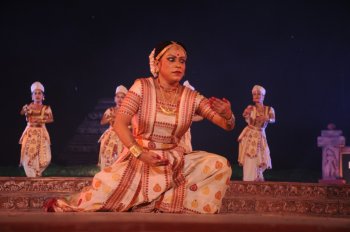 Anita Sharma's group 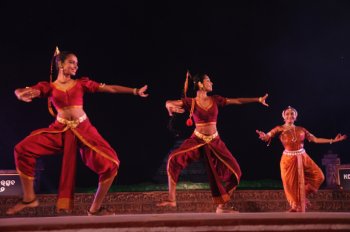 Nrityagram with Sri Lankan dancers The participation of Nrityagram dance ensemble consisting of Surupa Sen, Bijayini Satpathy, Pavitra Reddy and the two Sri Lanka dancers Thaji Dias and Mithilani Munasingha had already created a buzz and since their reputation had spread far and wide for collaboration of Odissi and Sri Lankan dances, there was expectancy in the air. Not only did they live up to their reputation, they created a stir and excitement not witnessed during these four days. They literally stole the show. Offering, Arapanam, a prayer in praise of Goddess Parvati, in which all the five dancers danced, the two Sri Lankans standing out with their wiry, slim bodies, full of energy and vigour, followed by a dance that combined the five elements – earth, water, fire, air, ether - to make ritual offering. The broad, expansive movements of Sri Lankan dancers found full expression later on in the final number Alap. Surupa and Bijayini's Vibhakta choreographed by Surupa was taken from the Sanskrit text of Sankaracharya 'Champeya guarardha.' Parvati's body of the colour of Champaka flower and Karpura (camphor) colour of Lord Shiva's body, the similes range from musk powder, ash of funeral pyre, bracelets of gold, multitude of glistening snakes, garland of mandara flowers, garland of skulls, Parvati draped in silk, Lord Shiva clad by sky – Digambara - and so on. Surupa and Bijayini interchange, coalesce, dance in ecstasy, stand together steady like rock, move with energy and extending bodies, strike sculpturesque images and captivate the audience. I never tire of seeing the Ardhanarishwara concept in their duet. The curiosity about the collaboration of Odissi and Sri Lankan dance met with great success. The meeting point between the sensuousness of Nrityagram's Odissi and the masculine dynamism of the Chitrasena Dance Company's Kandyan dance overwhelmed the audience. In the finale Alap, the Kandyan and Odissi dance traditions met in space, to challenge, combine and embrace each other through musical conversation and rhythmic dialogue. Surupa rendered the mnemonic syllables of Sri Lankan drum, the Sri Lankan drummer Udaya Kumara articulating them in vigorous sound texture. The two female dancers' bodies moved with swaying torsos, arms waving horizontally, three Odissi dancers matching them with their sensuous wave like movements to the rhythmic mnemonic syllables. At times, Odissi dancers played a game of dice with Sri Lankan dancers, or imitated movements of birds, animals, joyously running from one end of the stage to another, mesmerizing audience. The backdrop of Jagamohan shikhar as it were disappeared, the sky almost came down on to the stage. The Sri Lankan dancers, their typical head gear and long plaits with colourful decoration, moved a la snake, and all five dancers danced exuding sensuousness and masculine elements in a hypnotic manner - the audience was transported to a state of indescribable pure bliss. So overwhelming was the impact that the audience gave them a standing ovation. I was asked to do the honours and was deeply moved having watched something so full of life. The magic spell continued and many walked with a spring in their feet. I was overjoyed and realized how lucky I was to witness such wonderful dancing at Konark in the open air auditorium with the magic of the space. So powerful is the choreography and the teamwork of Indian musicians and Sri Lankan drummer that when writing this, I am able to relish it all in my mind's eye! Having known Protima Bedi and her vision of Nrityagram, I feel wherever she is, she is showering love on Surupa, Bijayini, Pavitra Reddy and Lynne Fernandez, the lights designer and in charge of Nrityagram. An unforgettable evening and indeed the highlight of the festival. Day five Dr. Malavika Mitra and her dancers of Sibpur Onkar Dances and Music Centre from Kolkata began in classical Kathak with Surya Vandana featuring eight dancers, ending with image of seven horses and a charioteer. Namo Mitraya, Bhanave namo, Saptashvarudha Prachanda Kashyapa shloka reverberating in the air, set the mood for further exposition of Kathak. In Samanvaya, Malavika explored char tala ki sawari and teen tala 16 beats, incorporating dha taka thunga bols, gat in which two male dancers as Krishna and other female dancers as gopis, circling around them, Malavika doing the padhanta, recitation of the Kathak bols, mnemonic syllables, using ginati, counting one, two three etc., at times executing pirouettes which won rounds of applause. In Krishna Katha using Bindadin Maharaj's composition 'Avat Shyam lachak mukut dhare' describing Krishna's beauty to the melodious singing, interspersing with traditional Kavits of Kathak, referring to Krishna's throwing ball in river Jamuna, dancing on serpent Kaliya's hood, the birds, animals all mesmerized by Krishna's flute, his divine powers, Malavika would have created more impact with exploring Kathak movements for each dancer, instead of them all performing the same stanza in a group. Tandava and lasya for two male dancers using Dhamar 14 matras, and for female dancers for lasya using Rupak, 7 matras, Malavika explored the tala elements alternating between tandava and lasya dance aspects. In a specially choreographed number, Malavika herself interpreted raga Bhupali using the Lakshana geet, which describes the 'rupa' of the ragini both as natavar and virahini nayika (nayika in separation). Her own solo displayed her command over the form, mastery over tala and laya and flawless execution of movements. For depicting Shankar playing damaru, Krishna playing bansi, Shiva dancing tandava, Krishna dancing gracefully, Malavika as a seasoned dancer gave glimpses of her maturity. Malavika concluded with Tarana, a well rehearsed group number. The musicians included Pt Dinanath Mishra (tabla), Pradip Banerjee (vocal), Sandip Niyogi (sitar), Jayanta Bhattacharya (sarod), Indranil Roy (harmonium) and Jawahar Mishra (flute). 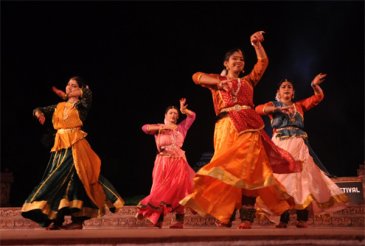 Malabika Mitra's group 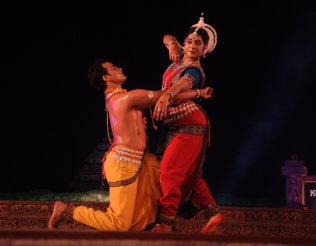 Ananga Ranga The final presentation Ananga Ranga was a combined presentation by dancers from Guru Kelucharan Mohapatra Odissi Research Centre and Utkal University of Culture. Based on Baldev Rath's Kishore chandranana champu, along with some stanzas from Kali Charan Pattanaik's champu, a group of more than 26 male and female dancers performed supported by a number of musicians. It was choreographed by Guru Durga Charan Ranbir and Prof. Naba Kishore Mishra, to music composed by Pt Ram Hari Das, music arrangement by Guru Keshab Chandra Rout and Guru Sukanta Kumar Kundu, who also rendered songs, vocal chorus by Bharati Jena, Anupama Pothal, Sarita Rout, mardala by Guru Dhaneswar Swain, Guru Satchidananda Das, khol by Guru Kalandi Charan Parida, sitar by Guru Swapneswar Chakravorty, violin by Agnimitra Behera and Laxmi Prasad Pattanaik. It began with an impressive tableau like opening sequence with dancers carrying fans made of peacock feathers and forming sculpturesque arrangements, showing Krishna and Radha in amorous mood, like a glimpse one got of the divine pair. It had a spectacular touch. The eleven male dancers performed with zest and looked quite energetic as they danced with synchronized movements across the vast stage, using two levels and moving with great agility. The female dancers entered gracefully and to the singing of Champu beginning with 'K' asking Radha 'ki hela?' (What happened?), the gopis tease her and with each repetition, Radha's infatuation for Krishna is further enhanced. There was recitation of sabdaswarapata also along with singing. The enactment with references to Krishna in guise of a gardener, 'chhalanamay lampat rasaraja,' epithets for Krishna, was represented in brief episodes. Krishna in guise of ferrying across Jamuna, Krishna stealing clothes when gopis were bathing, the season of spring, love, the bees hovering over lotus and several male dancers acting as bees, female dancers holding lotus hasta, pairs of male - female dancers in erotic poses, creating 'Ananga Ranga,' the mood of shringara Kamadeva generates, the group compositions were smooth and choreographed in a seamless manner giving the mis-en-scene an impressive look. One also noticed its deep roots in Jatra like action, close to the flavor of earlier dance drama presentations. With 'Arambhila Mohini Mohana,' singing to the divine pair, with blowing of the conch, the presentation concluded. It had popular appeal and the large scale on which it was mounted deserves applause. That all of them had worked as a team was obvious. The final presentation brought the festival to an end with a bang!
Daily along with the dance performances, in one corner on an elevated platform on a large canvas, renowned painter Baldev Maharath captured the mood and images of dance and the theme. That was an added attraction of the festival as was the International Sand Festival organized by Odisha Tourism department. In the end, due honours were done to performers, musicians, all participants, winners of International Sand Festival, those who participated in competition of paintings and sculpture, organizing team consisting of Ram Hari Das, Ratikant Mohapatra, Sangeeta Gosain, Jaidev, Chittaranjan Mallia, secretary of Odisha Sangeeet Natak Akademi and many more, too long a list to mention here. The comperes Sadhna Shrivastav and Dr. Mrityunjay Rath announced about the 25th edition of Konark Festival next year in 2013. The festival ended on a happy note. Those who attended for all the five days considered themselves lucky for where on earth can one have this amazing confluence of poetry, music, movements, painting, sculpture, monument of Konark, the Chandrabhaga beach, and the galaxy of dancers performing putting their hearts and soul into their presentation? Indeed Konark Dance Festival is a Festival of Festivals.  Dr. Sunil Kothari is a dance historian, scholar, author and a renowned dance critic. He is Vice President of World Dance Alliance Asia Pacific India chapter, based in New Delhi. He is honored by the President of India with Padma Shri, Sangeet Natak Akademi award and Senior Critic Award from Dance Critics Association, NYC. He is a regular contributor to www.narthaki.com, the roving critic for monthly magazine Sruti and is a contributing editor of Nartanam for the past 11 years. Post your comments Pl provide your name and email id along with your comment. All appropriate comments posted with name and email id in the blog will also be featured in the site. |